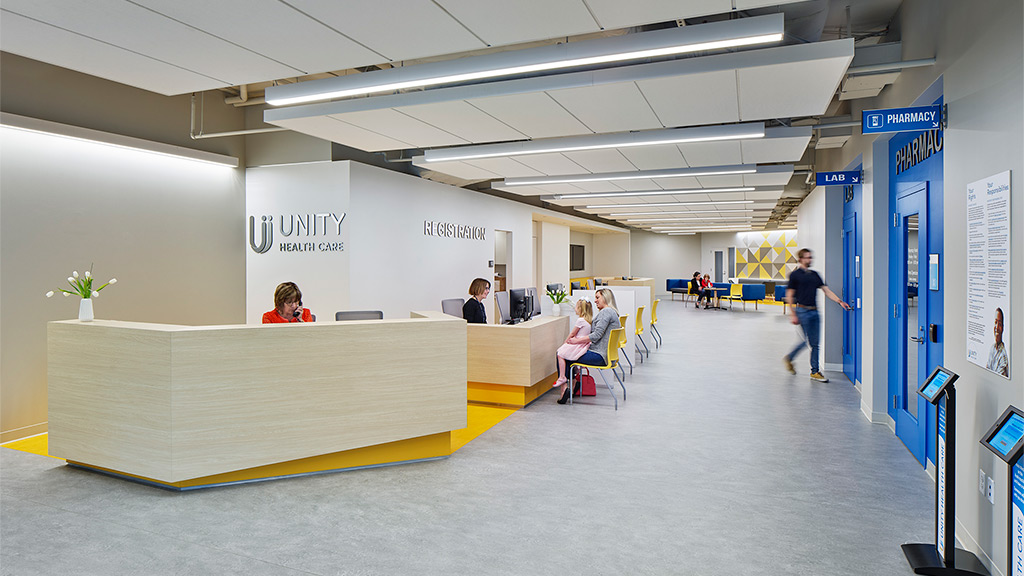Using Design Technology to Evolve Outpatient Healthcare Delivery
February 08, 2022 | By Joseph Joseph and Scot Latimer
One of the many trends accelerated by the COVID-19 pandemic, is that of healthcare providers moving care closer to home. Hospitals are essentially being decanted into the community, in the form of outpatient clinics and ambulatory care centers. This is an outcome of more people seeking care, but it’s also a matter of economics and building loyalty. As hospital reimbursement is reduced and operating margins remain extremely tight, providers can create efficiencies by shifting an increasing number of functions into lower cost settings.
This trend toward outpatient care is here to stay. For hospital outpatient departments and ambulatory surgery centers, patient volume is expected to increase by 15 million visits by 2029; over the same period, hospital emergency departments will see 5 million fewer patients. Hospitals will refocus their role in the system from a general catch-all to a more specific role focused on high-acuity care.
This shift can go a long way toward keeping American healthcare systems financially viable, and it holds a great deal of promise for patients. Outpatient care is generally cheaper than care delivered in a hospital setting, and often far more convenient. For example, Blue Cross Blue Shield estimates that a member saves $11,000 in electing for an outpatient knee replacement versus the inpatient alternative.
The key challenge: designing effective outpatient care at scale
For all its benefits, the outpatient care experience has plenty of room for improvement. Gensler’s Outpatient Healthcare Experience Index found that “only 50% of outpatient consumers rated the quality of their most recent interaction with their physician positively.” As more types of care shift to the outpatient setting, these environments will be called on to operate at a higher level than in the past. Providing care for less healthy segments of the population — as well as a greater proportion of it — will be no easy task.
As providers consider the future of their outpatient facilities, the ability to consider a range of design alternatives quickly and at scale is particularly important. Outpatient environments are distinct from hospitals in their need to support very high volumes of repetitive transactions. Like airports, they contain relatively few individual space types but bring together many multiples of these duplicative elements to create the experiences which lead to patient and provider satisfaction and loyalty.
In addition to meeting a plethora of technical and regulatory requirements, outpatient providers seek to create branded settings that will generate loyalty among patients and support staff retention. Both patients and providers must feel like they are in control of their experiences and have the necessary resources at hand.
When Gensler designs outpatient environments, our healthcare clients expect to consider every possible option on the table. They want to know, for example, the impact on wait times and patient flow from adding an exam room in one corner of a building versus another. There is undeniable value in determining these answers, but clients have traditionally had to weigh that value against the cost of the architect’s labor. The process of redrawing and recounting to assess the impact of each alteration used to be time-consuming, expensive, and at times unmanageable, but advanced computational algorithms and innovative data driven design are poised to change all that.
gFloorz is taking our clients on an engaging data-driven design journey
gFloorz 2.0 is the newest computational product within Gensler’s design technology NFORM™ ecosystem. Partnering with our clients, we identify their challenges in the form of key metrics and objectives. We then leverage these datasets and our design expertise to semi-automate, dynamically iterate, and endlessly reconfigure thousands of bespoke design outcomes. Whereas the first iteration of gFloorz focused on test fits for workplace interiors, version 2.0 is inclusive of all project types. It is specifically well-positioned to handle the complex environments that define the healthcare sector.
For example, gFloorz 2.0 enables us to take the inputs specific to outpatient care and reconfigure them rapidly. Using our advanced algorithms and projection models, we track critical space and business metrics, such as provider travel distance, care team and waiting room utilization, and grossing factor/space efficiency, giving the healthcare provider the exact insights they require during the design journey.
The ability to track and simulate these variations is exciting, but enabling our designers and clients to measure and predict the impact of their decisions with full confidence is what truly sets this journey apart. Changing patient flow, after all, changes distance of travel, access to daylight and other resources, and wait times for both patients and providers — all of which gFloorz 2.0 can quantify and assess in real time.
Because the inputs can be adjusted on demand, gFloorz 2.0 allows the client to take on a more active role in the design process. If they want to see what happens as a result of shifting total area from waiting and administrative uses into direct care, for example, those visual and technical implications are immediately available.
When healthcare providers see their business metrics and patient experience goals integrated directly into the design process, we see gFloorz 2.0 empowering them to make decisions more rapidly and with a with a higher degree of confidence than was possible in the past.
The outpatient experience is poised for a much-needed upgrade with the patient at the center
As provider groups have consolidated across geographies, we have increasingly been asked develop prototype clinics and then fit them to multiple sites in multiple markets as part of the roll-out. In doing so, our teams have gained an even deeper appreciation for what computational design could unlock.
Replication is indispensable for large-scale rollouts, and an efficiency gain multiplied one hundred times creates a big ripple in the pool. For leading health systems redefining their care models in large facilities, we see similar opportunities emerging — even under one roof.
New patient care technologies also enable providers to support personalized care journeys for patients. In the not-so-distant future, artificial intelligence algorithms enable health systems to customize a patient’s journey through a healthcare space based on their anticipated needs.
This means that rather than the one-size-fits-all model currently in use at outpatient facilities, differentiation in space types to meet these custom needs will flourish. It will become far easier for providers to create more pleasant and purposeful patient journeys, thereby conveying competence and increasing the patient’s engagement with their healthcare.
Frank Lloyd Wright once said, “An architect’s most useful tools are an eraser at the drafting board, and a wrecking ball at the site.” Today, design technology tools like gFloorz are replacing the eraser and making the wrecking ball obsolete. For the healthcare industry, innovative computational products combined with deep design expertise accomplishes something that was once intangible: predicting design’s effect on the healthcare experience, thus allowing our clients to design the best experiences they can for an increasingly large number of patients.
For media inquiries, email .

